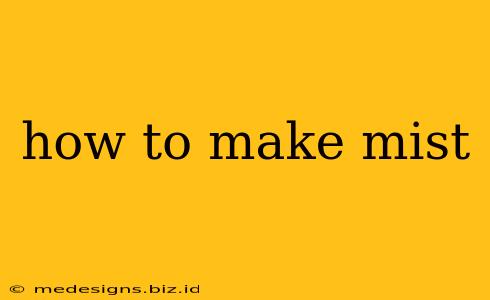Creating mist, whether for a theatrical production, a Halloween haunt, or simply a cool science experiment, involves understanding the principles of water vapor and condensation. This guide will explore various methods for generating mist, from simple household techniques to more advanced approaches.
Understanding Mist Formation
Before diving into the methods, it's crucial to grasp the fundamental concept: mist is essentially tiny water droplets suspended in the air. These droplets form when water vapor cools and condenses. The key to making mist lies in efficiently creating this cooling and condensation process.
Key Factors Affecting Mist Production:
- Water Source: The purity and temperature of your water source directly impacts the quality and density of the mist. Distilled water is generally preferred for avoiding mineral deposits.
- Cooling Method: The faster you can cool the water vapor, the more effective your mist production will be.
- Atomization: Breaking the water into incredibly small droplets significantly increases the surface area available for condensation, leading to denser mist.
Methods for Making Mist at Home
Several methods allow you to generate mist using readily available materials.
1. The Boiling Water Method (Simple Mist):
This method is the simplest and requires minimal equipment:
- Boil water: Boil a pot of water on the stove.
- Careful Observation: As the water boils, observe the steam rising from the pot. This steam is a form of mist, albeit a less dense one.
- Enhancement (Optional): Adding ice cubes to a plate near the steam can increase condensation and create a slightly denser mist.
Note: This method produces a relatively thin mist and is best for creating a subtle atmospheric effect.
2. The Spray Bottle Method (Fine Mist):
A spray bottle provides a more controlled approach:
- Fill the bottle: Fill a spray bottle with water (distilled is best).
- Spray: Spray the water into the air. The finer the spray, the more mist-like the effect will be.
- Experiment: Experiment with the spray distance and angle to achieve the desired effect.
Note: This method is suitable for smaller areas and creates a finer mist than the boiling water method.
3. Using a Humidifier (Dense Mist):
Humidifiers are designed to release water vapor into the air, creating a significant amount of mist:
- Fill the humidifier: Fill your humidifier according to the manufacturer's instructions.
- Turn it on: Turn on the humidifier and allow it to operate. The amount of mist produced will vary depending on the humidifier's settings and power.
Note: This method creates a denser and more sustained mist, ideal for larger spaces.
Advanced Mist-Making Techniques
For more dramatic effects, consider these advanced techniques:
1. Dry Ice and Water (Dramatic, Fog-like Mist):
This method produces a dramatic, low-lying fog:
- Caution: Handle dry ice with extreme care. It is extremely cold and can cause severe burns. Always use tongs and gloves.
- Combine carefully: Place dry ice into a container of warm (not boiling) water. The reaction will produce a thick, white fog.
Note: This is best suited for controlled environments and requires careful safety precautions.
2. Using a Fog Machine (Professional Quality Mist):
Fog machines are specialized devices designed to produce large quantities of dense fog. These are commonly used in theatrical productions and Halloween displays.
Note: Fog machines are generally more expensive than other methods but provide the most impressive and consistent mist output.
Conclusion: Choosing the Right Method
The best method for making mist depends on your specific needs and resources. Consider the desired density, area to be covered, and safety concerns when making your selection. From simple household techniques to advanced professional equipment, the possibilities are vast. Experiment and find the perfect method for creating your desired misty atmosphere.
